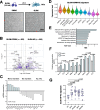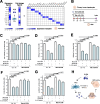TLR8 agonist selgantolimod regulates Kupffer cell differentiation status and impairs HBV entry into hepatocytes via an IL-6-dependent mechanism
- PMID: 38697771
- PMCID: PMC12210347
- DOI: 10.1136/gutjnl-2023-331396
TLR8 agonist selgantolimod regulates Kupffer cell differentiation status and impairs HBV entry into hepatocytes via an IL-6-dependent mechanism
Abstract
Objective: Achieving HBV cure will require novel combination therapies of direct-acting antivirals and immunomodulatory agents. In this context, the toll-like receptor 8 (TLR8) agonist selgantolimod (SLGN) has been investigated in preclinical models and clinical trials for chronic hepatitis B (CHB). However, little is known regarding its action on immune effectors within the liver. Our aim was to characterise the transcriptomic changes and intercellular communication events induced by SLGN in the hepatic microenvironment.
Design: We identified TLR8-expressing cell types in the human liver using publicly available single-cell RNA-seq data and established a method to isolate Kupffer cells (KCs). We characterised transcriptomic and cytokine KC profiles in response to SLGN. SLGN's indirect effect was evaluated by RNA-seq in hepatocytes treated with SLGN-conditioned media (CM) and quantification of HBV parameters following infection. Pathways mediating SLGN's effect were validated using transcriptomic data from HBV-infected patients.
Results: Hepatic TLR8 expression takes place in the myeloid compartment. SLGN treatment of KCs upregulated monocyte markers (eg, S100A12) and downregulated genes associated with the KC identity (eg, SPIC). Treatment of hepatocytes with SLGN-CM downregulated NTCP and impaired HBV entry. Cotreatment with an interleukin 6-neutralising antibody reverted the HBV entry inhibition.
Conclusion: Our transcriptomic characterisation of SLGN sheds light into the programmes regulating KC activation. Furthermore, in addition to its previously described effect on established HBV infection and adaptive immunity, we show that SLGN impairs HBV entry. Altogether, SLGN may contribute through KCs to remodelling the intrahepatic immune microenvironment and may thus represent an important component of future combinations to cure HBV infection.
Keywords: HEPATITIS B; IMMUNOTHERAPY; KUPFFER CELL.
© Author(s) (or their employer(s)) 2024. Re-use permitted under CC BY. Published by BMJ.
Conflict of interest statement
Competing interests: FZ and BT received grants from Assembly, Beam Therapeutics, Blue Jay and JnJ; FZ had consulting activities with Assembly, Blue Jay and GSK. YCH receives grants from Gilead Sciences and Sysmex. FZ is an associate editor of the journal. SD, LL, NK, JJW, AHL, and SPF are or were employees of Gilead Sc.
Figures






References
-
- World Health Organization Hepatitis B. 2022. [22-Jan-2023]. https://www.who.int/news-room/fact-sheets/detail/hepatitis-b Available. Accessed.
MeSH terms
Substances
LinkOut - more resources
Full Text Sources
Research Materials
Miscellaneous
